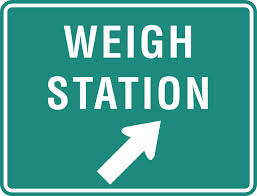|
We have One-stop Scales
Weight Tickets Types:
Vehicle Registration & Military Public Scales
Weight Certificate Official Public Weighmaster Scales |
Truck scales can be used for two main purposes:
They are used in industries that manufacture or move bulk items, such as in mines or quarries, garbage dumps / recycling centers, bulk liquid and powder movement, household goods, and electrical equipment. Since the weight of the vehicle carrying the goods is known (and can be ascertained quickly if it is not known by the simple expedient of weighing the empty vehicle) they are a quick and easy way to measure the flow of bulk goods in and out of different locations. Most states collect taxes based on the weight of transported goods. Truck weigh stations are used for these tax purposes as well as to monitor the weight of a truck to ensure that it falls within the safety guidelines that each state has in place for its road system. While the maximum allowed weight varies, a common standard is 34,000 pounds (15,400 kilograms). Weight is usually calculated in two measurements: A single axle truck scale or axle weighing system can be used to check individual axle weights and gross vehicle weights to determine whether the vehicle is safe to travel on the public highway without being stopped and fined by the authorities for being overloaded. Similar to the full size truck scale these systems can be pit mounted with the weighing surface flush to the level of the roadway or surface mounted. For many uses (such as at police over the road truck weigh stations or temporary road intercepts) weighbridges have been largely supplanted by simple and thin electronic weigh cells, over which a vehicle is slowly driven. A computer records the output of the cell and accumulates the total vehicle weight. By weighing the force of each axle it can be assured that the vehicle is within statutory limits, which typically will impose a total vehicle weight, a maximum weight within an axle span limit and an individual axle limit. The former two limits ensure the safety of bridges while the latter protects the road surface. Load-cell systems are the most popular technology used. Each cell is comprised of a durable material such as steel or concrete with one or more strain gauges attached to or embedded in it. A strain gauge consists of a wire (or wires) that transmits a mild electric current. As the cell is subjected to weight, the wire in the strain gauge is altered or compressed slightly. The change in the wire results in a difference in the resistance to the current passing through it. The signal from each cell is sent to a junction box, where sensors measure the variance in the current and calculate the amount of weight the scale is supporting. |


